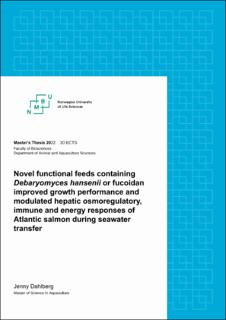| dc.description.abstract | Atlantic salmon (Salmo salar) is the most important farmed specie in Norwegian aquaculture industry that undergoes profound physiological and immunological alterations before and after seawater transfer (SWT). At this stage, fish are vulnerable to stress, physical injury, and infectious diseases. Poor smoltification and inadequate timing of transfer to seawater (SW) is associated with high mortality, which represents significant economic losses for the industry. Nutritional interventions and modulation of immune system using functional feeds could be part of the solution to these challenges. The objective of this thesis was to characterize the effect of the functional feeds, containing Debaryomyces hansenii yeast and fucoidan extract from the brown algae Saccharina latissima, on growth performance and transcriptomic modulation in liver related to osmoregulatory, immune and energy responses of Atlantic salmon during SWT. The liver was chosen as an organ of interest due to its central role in metabolic processes and due to the limited knowledge existing of the liver’s role regarding immunity during SWT. Atlantic salmon were fed either a control diet (C), a diet containing 0.2% of D. hansenii (D2) or a diet containing 0.2% fucoidan (D3) for 4 weeks in fresh water (FW) followed by 4 weeks in SW. The results showed that the growth performance was significantly enhanced for D2 and D3, especially in the FW phase. In addition, results from qPCR in liver showed up-regulation of energy related gene COX1 after SWT, suggesting that fish in D2 and D3 groups were better prepared to regain homeostasis in SW phase. Fish fed D3 showed up-regulation of genes related to osmoregulatory functions 4 weeks post SWT, indicating that they were better equipped of handling the acclimation to SW. Moreover, the immunity related genes hepcidin and Anxa1 were up-regulated in the D2 group in FW period, which might have been of advantage before SWT. Immunity related genes such as C3 and IL-10 were up-regulated for D3 group in SW phase, which might have been response to high pathogenic load. Both D2 and D3 enhanced immune modulating response with an increased gene expression of C3 and hepcidin, as well as of anti-inflammatory genes, which suggest immune homeostasis. To conclude, use of functional feeds containing D. hansenii or fucoidan enhanced growth performance and modulated hepatic gene expressions. Future work should be carried out to study how the functional feeds affect other immune active organs by use of transcriptomics and other multi-omics approaches and to illuminate the underlying mechanism of the bioactive components of D. hansenii and fucoidan. | |
